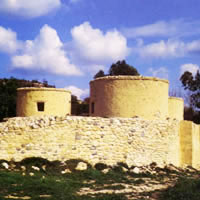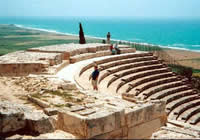|
|
| |
| |
| |
|
| |
 |
| |
|
| uses Google technology and indexes
only and selectively internet - libraries
having books with free public access |
|
 |
|
|
 |
|
| |
|
| |
Previous | |
Next |
|
 |
CLAUDE DELAVAL COBHAM
Exerpta Cypria
page 392 View PDF version of this page necessary to consult. The antient geography of Cyprus is involved in greater uncertainty than seems consistent with its former celebrity among enlightened nations. Neither Greeks nor Romans have afforded any cine by which we can fix the locality of its Eastern cities.
Certain of them, it is trne, had disappeared in a very early period. Long prior to the time of Pliny, the towns of Cinyria, Malium, and Idalinm, so necessary in ascertaining the relative position of other placée, no longer existed. Both the nature and situation of important land-marks, alluded to by the antient geographers, are also uncertain. According to Strabo, the Chides were tico islands upon the north-east coast; Pliny makes their number /our; and Herodotus mentions a promontory that had the name given to these islands. If we consult the text of Strabo, his description of Cyprus appears to be expressed with more than usual precision and perspicuity. Yet of two renowned cities, Salamis and CUium, the first distinguished for the birth of the historian Aristus, and the last conspicuous by the death of Cimon, neither the situation of the one nor of the other has been satisfactorily determined. D'Anville assigns a different position for those cities, and for the present towns of Famagusta and Larneca; although Drummond, "Vir hand contemnendus" as he is styled by a late commentator npon Strabo, and also Pococke, whose proverbial veracity is beyond all praise, from their own ocular testimony reconcile the locality of the antient and modern places. " At Larneca," observes the former of these writers, are undeniable proofs of its having been the antient Citium. Perhaps the antiquities now described may hereafter serve to confirm an opinion of Drunimond's, founded upon very diligent inquiry, and repeated examination of the country. During the time he was Consul at Aleppo, he thrice visited Cyprus, and upon every occasion industriously surveyed the existing documents of its antient history.
Tho sepulchral remains, occupying so considerable a portion of the territory where the modern town is situated, appear to have been those of the Necropolis of Citium; and this city probably extended from the port all the way to Larneca, called also Laraec, and Lamie (Larnaca is the name in most common acceptation among foreign nations ; but the inhabitants call it Ijarnec, and the Abbé Mariti writes it Lamie. The Bay of Salines is also sometimes called Larneca Bay); implying, in its etymology, independently of its tombs, "a place of burial"
Descending to later author*, we find this position of Citium strongly confirmed by the Abbé Mariti, who discovered very curious testimony concerning it, in a manueoript preserved at Venice. From his very interesting account cf Cyprus, we learn that the erroneous notions entertained with regard to the locality of the city, originated with Stephen do Lusignan; who was deceived by the name of a neighbouring village, called Citi, freni a promontory at present bearing that appellation. Mariti places Citinm between Salines and Larneca, upon the authority of the manuscript before mentioned, and the ruins he there observed. It is, as he remarks, of some importance to determine the trae situation of a city once so renowned, on account of the celebrated men it produced, and the splendid actions of which it was the theatre. Yet it is singular, that this writer makes no mention of its Phoenician origin. Concerning this fact so well ascertained, a few observations may therefore suffice.
Citium, from whose ruins we aliali now consider both the modem towns of Salines and Larneca to have arisen, was founded, together with the city of La pet bus, by a Phoenician King, of the name of Belus. Its inhabitants, according to Cicero, were originally Phoenicians. Cyprus, from its vicinity to their country, and its commercial advantages, was the first island of the Mediterranean that came under this dominion. Eusebius observes, that Paphos, a Phoenician city in Cyprus, was built when Cadmus reigned at Thebes. It is moreover affirmed by the learned Bochart, that before the time of the Trojan Avar, Cinyras, King of Phoenicia,
3«3
EXCERPTA CYPRIA.
View PDF version of this page
|
 |
| |
Previous |
First |
Next |
|
|
|